
Meeting of Disciples and friends of SDG
The Veterans of Foreign Wars Hall
845 Hudson Avenue
Stuyvesant Falls, New York 12174
There is plenty of parking near the Hall. The facility is just a few minutes’ walk from SDG’s home at 909 Albany Ave.
10:00 – 10:30 A.M. Kirtana
10:30 – 11:00 A.M. Presentation by Satsvarupa Maharaja
11:15 – 12:30 P.M. Book Table
12:30 – 1:15 P.M. Arati and kirtana
1:15 — 2:15 P.M. Prasadam Feast
Baladeva Vidyabhusana at [email protected] or (518) 754-1108
Krsna dasi at [email protected] or (518) 822-7636
SDG: “I request as many devotees as possible to attend so we can feel the family spirit strongly. I become very satisfied when we are all gathered together.”
******
Śrī Caitanya-caritāmṛta, Madhya-līlā 20.124–125: “O great learned devotee, although there are many faults in this material world, there is one good opportunity—the association with devotees. Such association brings about great happiness. . . . .”
Srila Prabhupāda: “Therefore, our Society is association. If we keep good association, then we don’t touch the darkness. What is the association? There is a song, sat-saṅga chāḍi’ kainu asate vilāsa, te-kāraṇe lāgila mora karma-bandha-phāṅsa (Gaurā Pahū, verse 3). Sat-saṅga. Sat-saṅga means association with the devotees. So the one poet, Vaiṣṇava poet, is regretting that, ‘I did not keep association with the devotees, and I wanted to enjoy life with the nondevotees. Therefore I’m being entangled in the fruitive activities.’ Karma bandha phāṅsa. Entanglement.” [Conversation with David Wynne, July 9, 1973, London]
“Hari Hari,
“Unfortunately the deluge of headaches continues. Satsvarupa Maharaja is getting two a day, some of them migraines which seem to linger all day long despite the specific migraine medicines that he takes for it.
“After talking with his doctor, we are going to try a one-month (April) sabbatical—no phone calls, no meetings, no extra guests. He will try to slow down the natural churning that goes on from producing new books. That puts him on a “meltdown course” to even think about it because he is so attached to sharing books with his readers. Every time he thinks about slowing down book production from his side, another interesting opportunity pops up.
Two dramas were cleared up today—the stairlift technician came and fixed his stair-chair, so now Satsvarupa Maharaja can come down to be with his devotees for lunch and get down to go to the doctor’s appointments much more easily. Climbing thirteen steep stairs up to his room is no easy task.
The other good news was that the once-a-month shot that really worked for migraines finally became available after being off the market for three months. The bad news was the insurance doesn’t cover it, so it cost over $600 for the month’s supply and emptied all the piggy banks. Hopefully the neurologist who prescribes it will get samples in this month and share a few with us. The cookie prasadam has worked like magic in the past, and let’s hope it works again.
“Baladeva”
Life in Lewes is mostly indoors . . . an early morning walk would be nice. When you have to carry a cane, however, you can’t count your japa, so the whole thing becomes not possible. No early morning japa walk. So you sit indoors and chant and hope you don’t fall asleep.
******
Whispering mantras, but regimented. Push the counter beads in order. Slide them down when a round is completed. He tells me there is a baseball game on TV . . . But I can be writing about Jesus Christ and Lord Krsna. I can be chanting japa.
******
Getting close to bedtime. Japa can be accomplished every day. Each individual has his speed. Japa can be accomplished at your pace. Each person has his own.
******
Chant early in the morning. Chant audibly. Have trust in the holy names. That is, be confident that if you “just hear” attentively, you will make immense gains. What more? Await lamentation. You are not really crying out to the names. Enjoy the exercise. Accumulate numbers, stay awake. Pronounce all the syllables.
******
At Govinda’s (restaurant and ashrama in Philadelphia) they hold Sunday morning group japa. They’ve invited me to join them. Could I chant without falling asleep in their midst? And then talk something about the holy names. I’m not scholarly. Could you say some basic things? Hare Krsna comes straight from Krsnaloka, but with chanting I have no connection. Day and night I’m burning in this dark world without seeking to make the connection . . .
******
Haryasva holds a japa class every Sunday in Philadelphia. We went this morning, Nitai-Gauranga and I. We reached Haryasva’s at 7:00 and sat and chanted with a group of about ten devotees. He has beautiful Panca-tattva Deities, with their arms upraised and the hands of Advaita Acarya and Srivasa Acarya folded in pranamas. After chanting, we had breakfast and then gathered again to discuss japa. He asked for realizations. I said one of the first realizations is that we have to chant the quota of sixteen rounds. That’s stated in one place by Prabhupada as the most important instruction of the spiritual master. Haryasva said it’s time we started relishing the holy names, not just doing them as duty. He recently attended a japa workshop and was full of enthusiasm from his association with those devotees. He had two books by Sacinandana Swami on the holy name, and he said he’ll get me copies of them.
******
Sometimes when I’m very sleepy in early morning japa, I play sacred music at low volume. It surrounds with an awakening ambience. It’s a mutual, ecumenical holy sound and doesn’t divert from Krsna conscious siddhanta. The choir singers are people, so it’s not impersonal; they are there with you, reminding you to stay awake and superimpose Hare Krsnas over the sacred music. It helps.
******
Days are short, with not much time to do things. Most time taken up chanting japa, taking a walk, a nap. Before I know it, the day is almost over. I don’t have much endurance, either. But as long as japa is done, the day is complete.
******
Salinger is good in Franny and Zooey. Franny is disillusioned with all aspects of life and is practicing the Jesus prayer. She has a nervous breakdown. In trying to bring her around, her brother Zooey tells her she’s going about the prayer in the wrong way. She’s following The Way of the Pilgrim by a nineteenth-century pilgrim, and Zooey tells her that varieties of the Jesus prayer have been chanted long before that. “It’s nothing new, for God’s sake,” he says. “It didn’t start with the little pilgrim’s crowd, I mean. In India, for God knows how many centuries, it’s been known as japam. Japam is just the repetition of any of the human names of God . . . the idea being that if you call out the name long enough and regularly enough and literally from the heart, sooner or later you’ll get an answer. Not exactly an answer. A response.” It was good to see a reference to genuine hari-nama in Salinger’s book.
******
Chanting is process. You just do it, and even if it’s shadow chanting, or even offensive chanting (nama-aparadha), you derive tremendous benefit. It’s the only religious sacrifice recommended in the age of Kali. That’s bricklaying. Building your way to the spiritual world.
******
Being friendly with devotees is a form of Krsna consciousness. Relaxing with them and talking about cooking or shopping or about other devotees is not necessary harmful. Some time should be spent, however, for concentrated krsna-katha, reading together, or sharing japa time. Here in the Singh household, Nitai-Gaurasundara is the first one to gather, by 5:00 A.M. or before that, in the living room. He sits in his bathrobe with a cadar over his knees and chants japa in a thoughtful, low voice. One by one, we join him and try to stay awake and chant attentively in the darkened room, until the sunrise gradually lightens the room.
******
Devotees are chanting in japa retreats. They report outstanding results, especially on the day when they observe mauna-vrata (vow of silence) and chant sixty-four rounds. A spiritual revolution. “Never before have I felt such ecstasy in chanting, after thirty-six years.” “I recommend it to everyone.” I attended one japa retreat and didn’t experience a long-term resolution, but I am more serious about my quota, and trying for some extra. The retreats are a good symptom of the times.
******
Reading in Sacinandana Swami’s book, japa should be no more than seven to eight minutes per round. A slower chanter should not think that the swift chanters are doing so mindlessly or mechanically. “They know the art.” That was a good reprimand for slow fault-finders.
******
We do not talk. Sit in chairs and view the fountain while chanting japa. Dattatreya said I am like Stephen Dedalus, living in my own world with my own thoughts. Stephen does not relate much to his peers or to the outer world. Hare Krsna mantras tumble out and get tallied. 108 x 16 = 1,728. Numerical strength is like building limber biceps. Prepare for the end. Improve in quality now because you won’t be able to later. You rapidly emit them, more in your mind than vocally. So many devotees do it better than you. Where are you in the list of best? Down among the thousands.
******
At least he does them as religious duty. Hare Krsna Hare Krsna . . . The mind goes everywhere. Where is full trust that simply hearing the sound vibration is a great value? You don’t have to know what it means to derive benefit. But it is better if you do. Hare is the energy of the Lord. Oh Radha. Krsna is the Lord, the all-attractive. The meaning is, “O Radha, O Krsna, please engage me in Your service.” The service begins with the tongue. Sevon mukhe hi jihvadau.
******
There is an exact way to say it properly. Sometimes people make a hissing sound, said Srila Prabhupada. Chanting is very easy, but it has to be practiced seriously. Such a simple thing is the most important thing. So many instructions on how to improve. He is not attentive. She is fatigued and too much “service oriented” to calm the mind and hear the mantras.
******
Healthy Krsna conscious devotees like loud kirtanas, and I do too, but for a limited time. I prefer the solitary japa when it’s going well. And solitary writing, reaching out to people with the pen (and printed word). Writing is communicative, intended to be read by others. For me, it is the best way to express myself and be with other people. Someone once criticized me and said I was a “virtual” devotee, meaning I existed only in theory or in the abstract, on the page, not in the flesh for face-to-face encounters. But I regard writing as good as “flesh.” As intimate as skin touching, and better. This may not be true for sense gratifiers who crave bodily contact, but it is operable in the science of spirit. You can be there in your words. “Camarado, he who touches this book touches a man.”
******
I don’t believe that a ghost can prevent someone from chanting his japa. If one is determined enough and chants loudly, surely the “evil” spirit, the mischievous jinn or whatever it is will be vanquished. As Jesus said to Satan, “Get thee behind me, Satan!,” so the reformed japa chanter can chase away the haunting specter or bad spirit. The devotee who has stopped his chanting because of the ghosts in his temple must be listening to “ghosts” within his own mind, because Krsna in His holy name is more powerful than any material illusory energy. As Krsna turned the two arjuna trees into beautiful demigods by tearing them down, so the holy names can tear down the ignorance that frightens one and dissuades one from chanting.
******
The rainstorm this morning chased the beachgoers. From our car, we saw porpoises gracefully rising from the water, displaying their top fin. For a while, japa was pure grinding with no taste. When we waked, it got better. What is it that makes it so empty and offensive? Your lack of attachment and affection. It becomes simply labor. A Spanish girl saw us walking and cried out, “Hare Kreeshna!” And we called it back. That made me feel better. Do extra rounds today to make up for the offensive morning moments.
******
Yadunandana has been showing me some exercises where you sit on the floor and do stretches. They are fairly easy, but I don’t know if I will be able to remember them after he leaves. Chanting japa is the most important exercise in the day, and I am not satisfied with my performance of it. Krsna sees I am trying, but not so successful. He will give me more mercy when I try harder to do it with devotion.
pp. 105-6
Lord Caitanya continued:
“O Svarupa Damodara and Ramananda Raya, please hear from Me the symptoms of how one should chant the maha-mantra to easily awaken one‘s dormant love of Krsna. One who thinks himself lower than the grass, more tolerant than a tree and who is prepared to give all respects to others, can very easily always chant the holy name of the Lord.”
The Lord expounded on the pridelessness of a Vaisnava:
“When there is a relationship of love of Godhead, its natural symptom is that a devotee does not think himself a devotee. Instead, he always thinks that he has not even a drop of love for Krsna.”
He then spoke another verse of Siksastakam:
“O Lord of the Universe, I do not desire wealth, followers, a beautiful wife or fruitive activities described in flowery language. All I want, life after life, is continued devotional service unto You.”
By saying “life after life,” He even gives up the desire of deliverance from the cycle of birth and death. The Siksastakam contains layers of meaning all pointed on pure devotional service to Krsna and chanting the holy names. One chants one‘s japa with these verses in mind and enhances his meditation.
Srila Sukadeva Goswami expresses the mood of the gopis when they met with Krsna at Kuruksetra:
“The gopis, who cursed the Creator for making eyelids that obstructed their darsana with Krsna, now saw Him after a very long time. They took Him from the path of their eyes into their hearts and tightly embraced Him there. They attained the rare absorption that cannot be attained by yogis or by Rukmini or the other queens of Dvaraka who are always with Him.”
The gopis control Krsna by their crooked, sidelong glances.
Enchanted by this prema-madhurya, the queens of Dvaraka pray to attain the fragrance of Krsna‘s lotus feet which are tinged with the kunkuma from the gopis‘ breasts. Blessed are these masterful gopis.
Rama Raya is living in painful separation from Aindra. He‘s dedicating his life to carrying out his friend‘s legacy in Vrindavana. Last night he played kirtana tunes for a devotee and I. One was for four-thirty P.M. when Krsna returns from the pasturing ground. And one was for ten P.M. when Krsna gets away to meet the gopis in the kunja.
Radha-Govinda receives my worship with a new stick of incense. I don‘t have to endure the Indian factor to get private leisurely darsana of Radharani. They are here in my room comforting me in my inability and unwillingness to travel. I play music to cheer me up. They stand gracefully in Their classic pose on my altar and I gaze upon Their beauteous forms.
pp. 26-28
The waves of love of God reached our shore. We were happy. Our dour face relieved. I suspected best friend of a change of heart but he appears to be on station doing the best he can. He is so different from you, that other person. Each one changing. Never get to know you? Or you don’t love me as I want?
When?
Maybe not in this lifetime. At least we are honest about it. And don’t desert the post of selling wares, or speaking as a sannyasi should. Grind out absolutes. Sastric melodies. Explain by repeating what previous acaryas have said. Your own explanation will suffice. Haribol.
C.c. says Lord Caitanya was permitted by His dear friends, including Lord Nityananda, the spiritual master, to go on His tour with only one servant. But many followed him to Alalanaatha. Then they parted. They fell unconscious. He walked away. “In separation, the Lord became very perturbed and walked on unhappily.” Then they fasted on that spot, and the next day they returned to Jagannatha Puri. And then, almost like a mad lion, Lord Caitanya went on his tour filled with ecstatic love, chanting Krsna’s name: Krsna! Krsna! Krsna! Krsna! Krsna! Krsna! Krsna! he!
It’s all right to chant Rama, the descendant of King Raghu, sometimes. God in His best name is Krsna in Hare Krsna. He chanted and induced everyone He met to chant. And that’s how we read, time passes and we get beyond the petty hindrances. Preach where it’s favorable.
I thought Basic Sketch Book might last months and hundreds of pages. You felt relaxed to put anything in it. Anything book. But after your post lunch nap you wake and nothing seems so possible. You feel lazy and without direction. You go to the bathroom to pass and that is an accomplishment. But can you ask much more than that? You read some, how the Lord demonstrates ecstasy in chanting wherever He goes, and the people who see Him go away maddened in prema. Whoever sees those people gets infected with it. The author says that what he says here is true for the whole tour of South India by Lord Caitanya. Everywhere He went He chanted and got those results. I am reading the diary of another pilgrim nowadays, and his journey is not like that. We are tiny and can’t do anything much. He goes alone and tries to be celibate and loses weight by fasting. Yes, live alone yet think with rage of those you have wronged. The random nature of this. I want it to be good. But you need to relax with it. Just accept it please.
Planning out months ahead, I see in July there is very little time for any full-time writing. This displeased me. But when I have a day, or few, that doesn’t seem enough for me to get underway in momentum. You just sketch in this book. The concept was clearer yesterday. You mean like a person who draws in his sketchbook and he puts many things in it? You are sketching in prose. You are sketching notes while you read the Cc.
You are very basic also. That means you are a beginner. You emphasize the importance of chanting and reading. You are basic because you repeat your spiritual master’s teachings, and you’re not interested in going elsewhere in Gaudiya Vaisnava books? Basic in your own interests to get out of bodily identification. Yes, basic. I want to pay attention when I chant the holy names.
And in writing my little life and the thoughts that come, I sketch them into this book. There is no tight structure required and no pressure of performance. But then what kind of a result will you get from that?
Will you at least be able to practice the art of devotional writing? Put down here what is honestly your thoughts and day? Be courageous to say that you are getting out of the way of meetings and staying alone? And that you don’t read or write very much? Could you admit to that? Old rocking chair got me?
The basic act of writing something down. It is done to save the moment. To express something, to record devotional truth of the scriptures. Quiet despair.
pp. 234-36
I don’t understand Khelanavana. I have heard the story told briefly. I like to collect stories about krsna-lila, but it would be better if I could feel even one of them enough that I could cry in separation, like the brahmana in South India who cried when he thought of Krsna’s kindness in driving His friend Arjuna’s chariot.
When Krsna left for Mathura, Radharani wouldn’t accept it at first. She continued to search for Him through all of Vraja’s villages and forests. At that time, She met Lalita and suggested they look in Khelanavana because Krsna used to like to play there. This is a place, again, which commemorates the depth of Her feelings of separation from Krsna.
I can’t understand the feelings of separation, the pain of Krsna’s loss, and the simultaneous bliss of internal union with Him. I can’t hold either bhava in my mind, not even for a moment.
When Balarama saw that Krsna (in His expansion) was not going to return to Vrndavana to ease the suffering of His parents and dear friends, He decided to go Himself. He came to Rama-ghata.
We are at the same Rama-ghata. The Yamuna is here, and it breaks into several tributaries. The sun is setting over the water. Let us think of Balarama’s mood in coming, and let us hear of Krsna’s mood in not returning. Balarama pacified -those gopis who were Krsna’s beloveds by telling them that Krsna would soon return. With His own group of gopis, Balarama performed a rasa dance. He then tasted varuvi, and when the Yamuna River would not come to Him, He forced her with His plow.
One pen after another won’t work out here. It’s too cold. The ink keeps freezing up. I’m going inside soon anyway.
I am happy to write, and grateful to Krsna for the privilege. I don’t just mean that I’m grateful to write; I’m grateful to write on Krsna conscious topics. By writing in Krsna consciousness, we can please ourselves and others. Bhaktisiddhanta Sarasvati said we could write a full spiritual edition of a newspaper at every moment, there is so much good news flowing from the spiritual world.
The yatris are camping for the night. I’m scheduled to speak to them. I will choose to read from Krsna’s pastimes. We’ll hear what Sukadeva says, and Srila Prabhupada.
Now be calm. I have visited many places today. I still have my kadamba ball from Ter-kadamba. Although my mental parikrama will soon be over, I hope to do this perpetually. Sanatana Gosvami circumambulated Giriraja-Govardhana every day. Raghunatha dasa Gosvami lived on the bank of Radha-kunda.
It’s cold and clear, a Friday night. The muddy ridges have refrozen and there is a powdering of snow on the ground. Weekend carousers will drive and park in The Woods tonight, and I will see their debris in tomorrow’s first light. We yatris want to take rest early.
Oh, I almost forgot. Of course, there’s an evening program for the public tonight. Lights and lecture, if the electric sound system holds up. Maybe there will even be a slide show or video. Then prasadam. I’ll be there. But when we finally do take rest, maybe the names of the places we visited today will return to me, and the pastimes Krsna performed there: the place where mother Yagoda throws away the milk, the place where Balarama asked Krsna, “Are You all right?”, the place where the demon ran with Krsna in pursuit, where Prabhupada heard his Guru Maharaja, where Radha washed Her hands clean of the turmeric, where Yagoda bathed, where Jatila lives and causes the pain of separation to rise in Her daughter-in-law . . . and Ter-kadamba, where Radha walks every day and Krsna hopes to meet Her, where Rupa Gosvami wrote and the tree shed its leaves in sorrow. The big rock the gopas slide down, the narrow mountain pass, the smile of Radha, the pride of foolish Abhimanyu, my own inability to remember and absorb . . . The mercy of Vrndavana is even greater than my inability to remember it.
pp. 127-29
In this picture Prabhupada is solemnly saying his Gayatri mantras while sitting on the bank of the Yamuna in Vrndavana. Some devotees say that when you say your Gayatri you should cover your hand with your cloth. The rumor is that if the demigods see you chanting Gayatri they will get jealous and do you harm. In this picture Prabhupada is not covering his hand with his cloth. Jayadvaita Swami has pointed out that there are several photos of Prabhupada saying his Gayatri with his hand uncovered. J. S. concludes that the demigods’ jealousy is just a rumor or myth, and that we don’t have to cover our hand doing Gayatri.
Saffron clothes are seen scattered around on the ground. Prabhupada’s disciples are stripped down to their kaupinas and are standing in the Yamuna saying their Gayatris and playing in the water. Sometimes Prabhupada would say that he would not go in the water for Gayatri but just touch it to his head. But then he gradually began to take his clothes off and join his men in the water wearing just a gamsha. It was a great thrill and pastime to play in the Yamuna with Srila Prabhupada. Devotees would gently splash water on Prabhupada’s body and massage his limbs. He would hold his fingers over his nostrils and take a full dip under the water. How kind he was to associate and play with us in such a familiar way.
******
This is a photo of Prabhupada in the early years of ISKCON. He was lecturing near the veranda between his room and his kitchen at Radha-Damodara temple in Vrndavana. As yet he had no temples in India, none in Vrindavana, Mayapur or Bombay. All this will come in the future, and he is patiently poised in the present. Prabhupada was a perfect combination of patience and drive. He was content to live with just a few followers, staying alone at his Radha-Damodara room. But he pushed his disciples to develop big projects where many visitors and guests could come and take advantage of living in the dhama. He did not exactly know how things would get done, but he depended on Krsna. As it turned out, by the outburst of book distribution in the West, much money was collected and with collections from other parties.
Gradually land was purchased, architectural plans were made, cement was acquired and the buildings went up. There were delays, cheating by landlords and contractors, but progress went forward. Prabhupada wrote his books in the same way, slow but steady. He would rise every night at 1:00 A.M. and do some dictation of translations and purports. He used to say, “Little drops of water wear away the stone. In this way I have written all these books.” In this way the temple construction also went forward. Overcoming the constant “Indian factor,” the construction of the buildings actually went quickly. Prabhupada, as the manager, could create pressure on his disciples who could create pressure on the construction people, and he created a regular empire of buildings and printed books. In another context he said it was the desire of Krsna that the temples were constructed. Krsna wants to fulfill the desires of His devotees. So a devotee desired “let there be a temple” and from the deserted field in Raman-reti a great temple was constructed. A devotee desired that the order of his spiritual master to get money and print books be fulfilled, and it was fulfilled.
******
Prabhupada would always look very gravely at the Deities in the Krsna-Balarama Mandir. The surrounding devotees reflected Prabhupada’s mood. The Deities— whether They be Gaura-Nitai, Krsna-Balarama or Radha-Syamasundara—all project light, smiling moods, so why does Prabhupada look so heavy? It is a look of ecstatic devotion. We read of the symptoms of physical ecstasy as exhibited by Lord Caitanya or any devotee on the advanced platform and they are varied: laughing, crying, morose (in separation), stunned, feelings of unworthiness, hair standing on end, etc. It is not that Prabhupada has to reflect the light mood of the Deities’ faces in order to be in proper tune of reciprocation. His devotion is like an ocean with various waves. And his demeanor controls that of his disciples. They take their cue from Prabhupada and only want to follow him.
I don’t think he is displeased with the decoration of the Deities, because he always supervised the pujaris and made them keep a high standard. The Deities were beautifully dressed and garlanded with many fresh flowers. Prabhupada is feeling transcendental emotion; he is not looking at a statue and feeling empty. Once a devotee looked at Prabhupada’s passport photo and said, “You look very sad in this picture.” In the photo Prabhupada wore no kurta but only his sannyasa top and dhoti and neat tilaka on his arms and forehead. But the corners of his mouth were turned down. He replied to the disciple, “That was a moment of ecstasy.” Many pictures of Caitanya Mahaprabhu in the gambhira show Him with a sad-like expression. Gambhira means grave or deep. Prabhupada here is gambhira, or deep, and his emotion is very wonderful.
pp. 19-22
What is clever? What is
acceptable anger?
What is right for me? What
will look good? Can I make
a joke? Am I entitled?
Should I be ashamed? (Of America?)
Should I preach like Narada Muni
and declare it a mirage?
Where is God? Which page and chapter of
Srimad-Bhagavatam?
What is the Bible? The Koran?
(Did you ever read them?)
What do you know?
Can you put these questions aside
and tell what you saw and felt
a slice? Two cats, one black, one black-white sitting
peacefully and close together
on a morning patio—don’t tell me
it’s a lie because I saw
it. And barking dogs. The small
one knows exactly how far it can go
and when to back down.
We can learn a lot by watching dogs.
Hidden away in a heart, Raghunatha dasa Gosvami
leans on his hand and Rupa Gosvami chants japa under
a kadamba tree.
Radha and Syama look my way
and yours, the gurus in Parampara
in Bengali colors so rich
seeing them is like entering
a rice field at full flood.
Prabhupada in his rocking chair,
pausing, protects me.
I want his shelter I
need
his shelter. I’m getting
old.
Too much youthful energy bewilders me,
bores me. A pond with minnows in it.
O Prabhupada, you didn’t leave us to grow old
under the clouds. You wanted us to do as you did,
to travel by planes even if it was bad for our health
and to use our life’s blood to serve others
to be truly anyabhilasita-sunyam.
Come on, old man,
come down from the mountain
and remember Prabhupada
who came down from Goloka.
Don’t retire now.
Stopwatch—I use one to time my rounds, not
really seeking speed but I race a round, then
forget it.
I go my way.
No more time—I gave up so much
for Krsna in all things. Ironic now
that my life is so quiet despite the dissonance of art.
Read Merton and the phrase,
“Women of the Veil.”
What does it mean?
Nuns or just the opposite?
It means lonely notes here and
there and me happy it’s mid-October
so I can feel grateful for a day
like no other.
Prabhupada, what does it take to sustain
this Krsna conscious life?
Look at those young men with outlooks
different from mine. Are they showing off
or are they simply friends, their
intellects and bodies and futures and parents
all still to be contended with?
I was lucky to get in at the beginning.
Swami was there and I liked it.
I had a bass fiddle and left it
at the front of the store. They sold it.
I gave away stuff and entered the door
naked, you could say, but covered.
Now I’m better? I’m hurrying this
up while we don’t make pancakes
but simple porridge.
O disciples! You belong to God
and Swami. I can only help you in
my simple way to tell you God—
Hare Krsna chanting is good.
I want Krsna to be pleased with
a blue offering—
I mean
I showed it to a prof
who was a sannyasi but he only
furrowed his brow not quite sure
what I was getting at. I saw
I didn’t want to share my secret so openly.
But I told another friend
that friends are like this—
protect one another’s solitude (Rilke).
Gone are the days when I would
go all out, diving headlong into lyrical
romance, romancing lyrics,
not containing anything
reducing anything
over the moon
in love,
love
love with genius
poetic
such love was grand.
Remembering running off the Sara News
late at night on the mimeograph machine
all alone, the phonograph playing
“Chasin’ the Trane”—
me breaking apart, meeting
chaos
and the end of it.
The end.
Krsna, Lord of all blue things,
please accept my offering of solitude.
pp. 9-11
Most of us did not come to the Krsna consciousness movement because we wanted to help others. We came because we wanted to help ourselves. Still, here we are, and Krsna consciousness does provide the answer to what we can do to really help people—we can preach.
The desire and willingness to preach is a blessing, because the enthusiasm to preach comes from Krsna and from association with Krsna’s compassionate devotees. It does not come simply by being a member of a compassionate institution. We ourselves must develop actual compassion—the ability to feel others’ suffering, accompanied by the desire to do something about it.
For the members of ISKCON, it is crucial that we are convinced of our own path and that we understand how others can be benefited by sharing it. Nowadays, so many devotees have lost their faith in the pure preaching machinery of the Krsna consciousness movement. They may have retained their faith in the philosophy but become disappointed in the movement’s direction, which seemed more based on finding name and fame than on compassionate outreach. Some devotees have also lost their faith that Krsna consciousness is the panacea. But just to remember the taste of conviction we have or once had that Krsna consciousness is what people really need, and the drive we felt to give it out in some way or other!
I think what devotees have discovered is that it does not always seem enough to hand out a book full of perfect knowledge or to open a temple. We want there to be a quality to our compassionate activity; we want to be consciously trying to help others. Srila Prabhupada had that quality to his preaching. Sometimes he would speak about abortion or the suffering of cows, and a tear would appear in his eye. Often those who witnessed such moments were surprised that someone could actually feel emotion about situations we take for granted. We ourselves are often so limited in our ability to feel others’ suffering.
Therefore, our outreach can begin in a smaller circle. We can start with ourselves and work from there. When we begin to express compassion in a smaller circle, it becomes easier to develop the qualities that support compassion—courtesy, friendliness, and kindness—all of which are also listed among the qualities of a devotee. In ISKCON we have seen that claiming a wider feeling of compassion than we actually possessed only caused us to become arrogant. That smaller circle might include showing compassion toward family members, for example.
But didn’t Srila Prabhupada consider such compassion limited, even material? When Arjuna expresses his natural compassion for his family members while standing on the battlefield, Srila Prabhupada comments:
Arjuna’s deep affection for community and family members is exhibited here partly due to his natural compassion for them. He is therefore not prepared to fight. Everyone wants to show his opulence to friends and relatives, but Arjuna fears that all his relatives and friends will be killed on the battlefield and he will be unable to share his opulence after victory. This is a typical calculation of material life. The transcendental life, however, is different.” (Bg. 1.32-35, purport)
It is important, therefore, that we remember that the essence of compassion is to give others Krsna consciousness. Caring for others does not mean engaging in sense gratification with them; our natural compassion can easily be diverted into hypocrisy if we associate with ignorance. Compassion is not a superficial quality, and as Prabhupada taught us, is not based on bodily identification but on recognition of ourselves as spirit souls and the desire to help other spirit souls.
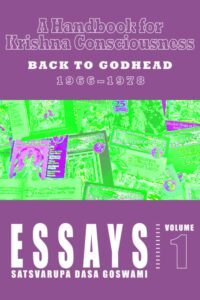
This collection of Satsvarūpa dāsa Goswami’s writings is comprised of essays that were originally published in Back to Godhead magazine between 1966 and 1978, and compiled in 1979 by Gita Nagari Press as the volume A Handbook for Kṛṣṇa Consciousness.
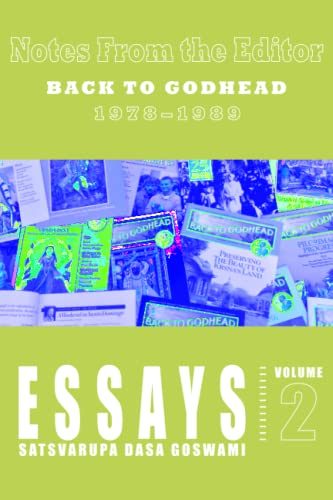
This second volume of Satsvarūpa dāsa Goswami’s Back to Godhead essays encompasses the last 11 years of his 20-year tenure as Editor-in-Chief of Back to Godhead magazine. The essays in this book consist mostly of SDG’s ‘Notes from the Editor’ column, which was typically featured towards the end of each issue starting in 1978 and running until Mahārāja retired from his duties as editor in 1989.
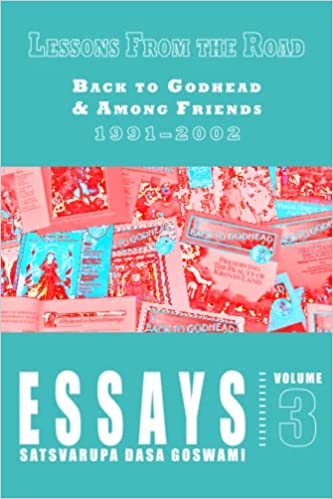
This collection of Satsvarupa dasa Goswami’s writings is comprised of essays that were originally published in Back to Godhead magazine between 1991 and 2002, picking up where Volume 2 leaves off. The volume is supplemented by essays about devotional service from issues of Satsvarupa dasa Goswami’s magazine, Among Friends, published in the 1990s.

“This is a different kind of book, written in my old age, observing Kṛṣṇa consciousness and assessing myself. I believe it fits under the category of ‘Literature in pursuance of the Vedic version.’ It is autobiography, from a Western-raised man, who has been transformed into a devotee of Kṛṣṇa by Śrīla Prabhupāda.”
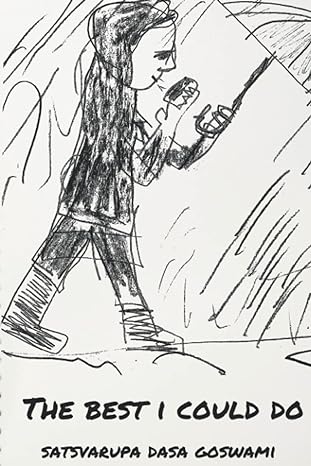 The Best I Could Do
The Best I Could DoI want to study this evolution of my art, my writing. I want to see what changed from the book In Search of the Grand Metaphor to the next book, The Last Days of the Year.
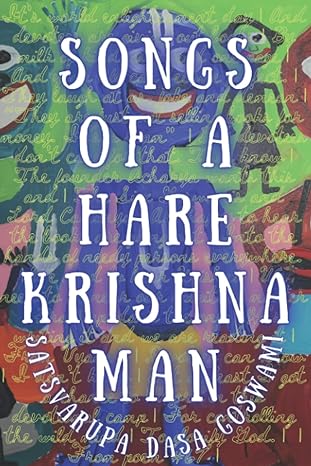 a Hare Krishna Man
a Hare Krishna ManIt’s world enlightenment day
And devotees are giving out books
By milk of kindness, read one page
And your life can become perfect.
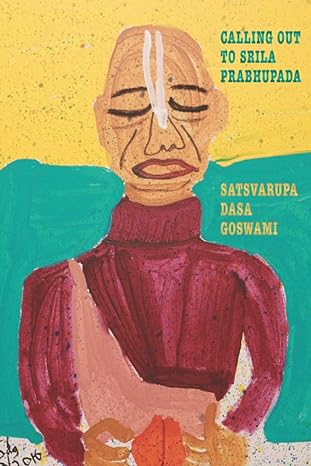 Calling Out to Srila Prabhupada: Poems and Prayers
Calling Out to Srila Prabhupada: Poems and PrayersO Prabhupāda, whose purports are wonderfully clear, having been gathered from what was taught by the previous ācāryas and made all new; O Prabhupāda, who is always sober to expose the material illusion and blissful in knowledge of Kṛṣṇa, may we carefully read your Bhaktivedanta purports.
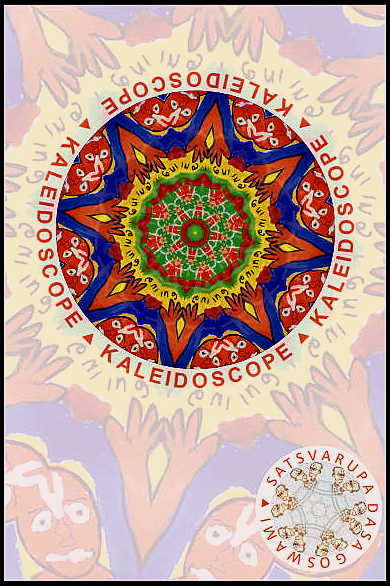 Kaleidoscope
KaleidoscopeStream of consciousness poetry that moves with the shifting shapes and colors characteristic of a kaleidoscope itself around the themes of authenticity. This is a book will transport you to the far reaches of the author’s heart and soul in daring ways and will move you to experience your own inner kaleidoscope.
Read more »
 A narrative poem. challenging and profound, about the journey of an itinerant monk who pursues new means of self-Seeking New Land
A narrative poem. challenging and profound, about the journey of an itinerant monk who pursues new means of self-Seeking New Landexpression.The reader is invited to discover his or her own spiritual pilgrimage within these pages as the author pushes every literary boundary to boldly create something wholly new and inspiring.